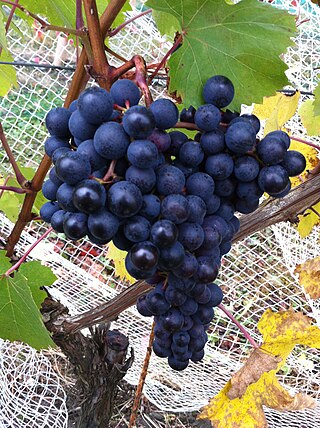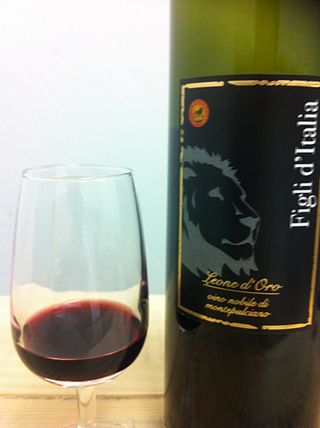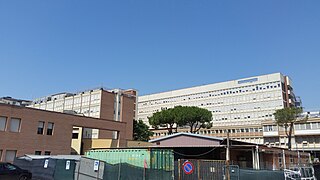
Dolcetto is a black Italian wine grape variety widely grown in the Piedmont region of northwest Italy. The Italian word dolcetto means "little sweet one", but it is not certain that the name originally carried any reference to the grape’s sugar levels: it is possible that it derives from the name of the hills where the vine is cultivated. In any case the wines produced are nearly always dry. They can be tannic and fruity with moderate, or decidedly low, levels of acidity and are typically meant to be consumed within a few years after release.

Italian wine is produced in every region of Italy. Italy is the country with the widest variety of indigenous grapevine in the world, with an area of 702,000 hectares under vineyard cultivation, as well as the world's second largest wine producer and the largest exporter as of 2023. Contributing 49.8 million hl of wine in 2022, Italy accounted for over 19.3% of global production, ahead of France (17.7%) and Spain (13.8%); the following year, production decreased by 11.5 million hl, and Italy was surpassed by France. Italian wine is also popular domestically among Italians, who consume a yearly average of 46.8 litres per capita, ranking third in world wine consumption.

Aglianico del Vulture and Aglianico del Vulture Superiore are Italian red wines based on the Aglianico grape and produced in the Vulture area of Basilicata. Located on volcanic soils derived from nearby Mount Vulture, it was awarded Denominazione di Origine Controllata (DOC) status in 1971. The Superiore was elevated to a separate Denominazione di Origine Controllata e Garantita (DOCG) status in 2011, the only DOCG wine in Basilicata.

Vino Nobile di Montepulciano is a red wine with a denominazione di origine controllata e garantita status produced in the vineyards surrounding the town of Montepulciano, Italy. The wine is made primarily from the Sangiovese grape varietal, blended with Canaiolo Nero (10%–20%) and small amounts of other local varieties such as Mammolo. The wine is aged for 2 years ; three years if it is a riserva. The wine should not be confused with Montepulciano d'Abruzzo, a red wine made from the Montepulciano grape in the Abruzzo region of east-central Italy.

Marchesi Antinori Srl is an Italian wine company, based in Florence, Tuscany, that can trace its history back to 1385. They are one of the biggest wine companies in Italy, and their innovations played a large part in the "Super-Tuscan" revolution of the 1970s.

Tuscan wine is Italian wine from the Tuscany region. Located in central Italy along the Tyrrhenian coast, Tuscany is home to some of the world's most notable wine regions. Chianti, Brunello di Montalcino and Vino Nobile di Montepulciano are primarily made with Sangiovese grape whereas the Vernaccia grape is the basis of the white Vernaccia di San Gimignano. Tuscany is also known for the dessert wine Vin Santo, made from a variety of the region's grapes. Tuscany has forty-one Denominazioni di origine controllata (DOC) and eleven Denominazioni di Origine Controllata e Garantita (DOCG). In the 1970s a new class of wines known in the trade as "Super Tuscans" emerged. These wines were made outside DOC/DOCG regulations but were considered of high quality and commanded high prices. Many of these wines became cult wines. In the reformation of the Italian classification system many of the original Super Tuscans now qualify as DOC or DOCG wines but some producers still prefer the declassified rankings or to use the Indicazione Geografica Tipica (IGT) classification of Toscana. Tuscany has six sub-categories of IGT wines today.

Giorgio Rossi Cairo is an Italian entrepreneur. He is managing director of Value Partners, the management consulting multinational he founded in 1993.
Angelo Torricelli is an Italian architect.
Poggi del Sasso is a village in Tuscany, central Italy, administratively a frazione of the comune of Cinigiano, province of Grosseto. At the time of the 2001 census its population amounted to 88.

Roccamare is a village in Tuscany, central Italy, administratively a frazione of the comune of Castiglione della Pescaia, province of Grosseto. At the time of the 2001 census its population amounted to 107.

Vincenzo Eusebi is an Italian engineer, architect and designer. Eusebi studied engineering and architecture at the Marche Polytechnic University in Ancona.
Castiglion del Bosco is a wine estate which produces Brunello di Montalcino and was one of the founders of Brunello di Montalcino Consortium. It is located in the comune of Montalcino in the province of Siena, Italy, within the Val d’Orcia nature reserve, a UNESCO World Heritage Site.
Ernesto Ganelli was an Italian civil engineer who designed various public and religious buildings in Tuscany.

The Misericordia Hospital is a hospital located in Grosseto, Tuscany, Italy.
Walter Di Salvo was an Italian architect responsible for planning the layout of Punta Ala.
Emilio Suardi was an Italian politician and partisan.
Rocca di Frassinello is a contemporary-style winery located in the municipality of Gavorrano, in the province of Grosseto, Tuscany. The structure, designed by Renzo Piano and home to the eponymous winemaking company, is part of the Toscana Wine Architecture circuit of design wineries and is considered one of Italy's "cathedrals of wine". Inside, it also houses the Etruscan museum of Gavorrano.

Edoardo Milesi is an Italian architect.












